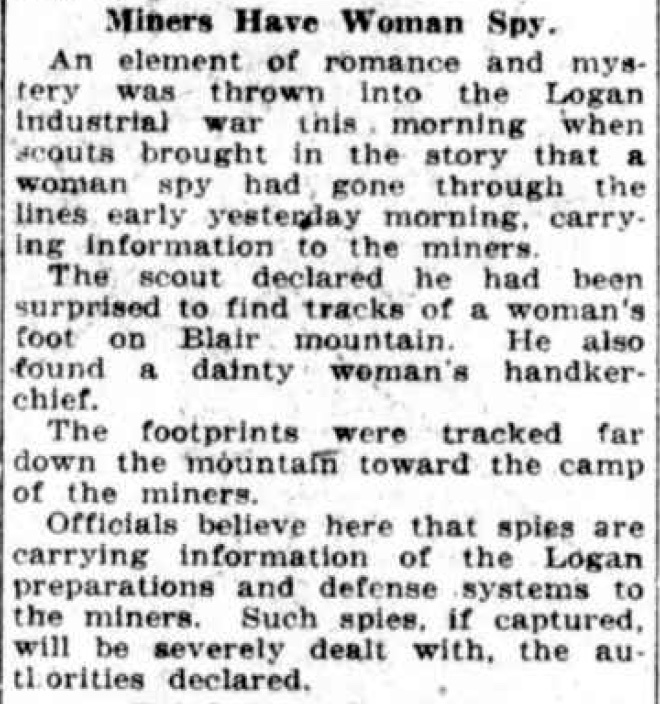Women on the Front Lines
As the unlikely weapon of the mine wars, women volunteered for missions in which they would be completed unsuspected, such as becoming a spy across enemy lines, as documented here.
Interestingly, the newspaper writes that the idea of a woman spy has both “an element of romance and mystery” and mentions a “dainty” woman’s handkerchief, juxtaposing femininity against the harsh reality of war. These women spies frequently put themselves at great risk; the 1921 Library of Congress newspaper reported officials as saying, "Such spies, if captured, will be severely punished." In addition to delivering valuable information to the miners, women also transported weapons. In collected interviews, one woman reported transporting guns regularly, using her dress to hide the musket (Public Broadcasting Service, 2021). When scabs arrived from out of town to work in the mines, women would crowd the train tracks, even tearing up the track. (Public Broadcasting Service, 2021). As scabs flooded onto the platform, women would curse at them, spit at them, and even engage in fighting. To protect themselves, some women would carry guns openly (Public Broadcasting Service, 2021).
These women were fiercely protecting their families and were willing to lay their life on the line for the cause. In a separate interview, a man present at the scene of the fighting recalls his aunt stomped a strikebreaker in the face, knocking his teeth out and nearly killing him – all while she was several months pregnant (Rothman, 2016). Clearly, their involvement knew no bounds, and the opposition made a grave mistake in underestimating what the women in the coal camps were capable of.
Serving on the front lines did not always entail physical fighting. The 1921 Library of Congress newspaper publication recorded that women – along with their children – presided over the field kitchens. They worked tirelessly to provide food and other supplies to those on the front lines. The kitchens noted by the newspaper were just "back of the front," which shows how brave these women – so close to combat – were.
These women who relocated from a peaceful environment to a warzone were extremely adaptive. As primary caregivers of their children, the mothers were forced to bring the children along with them. The field kitchens were close to the ridges that the men commandeered (Library of Congress, 1921). The fighters were known as "gaunt and hollow-eyed." There is no doubt that the women aiding the front lines were also exhausted, but they and their children pushed through in support of the cause.
Since coal camps (or "tent colonies") were prevalent in that time, women were already used to extreme temperatures and harsh conditions (Lana Harlow, 1972). Many women's partners had left for protesting already, so they were already taking up the men's chores. This prepared them for the even harsher environment of war.

